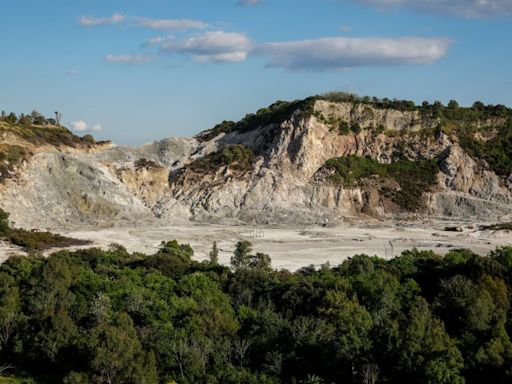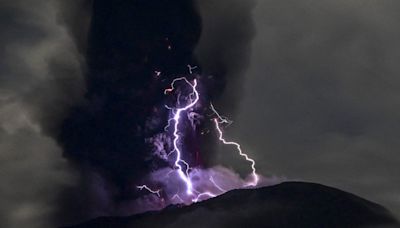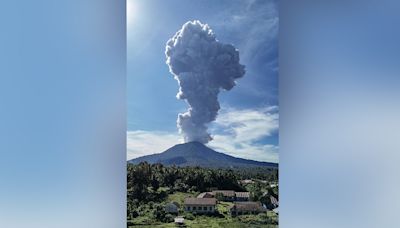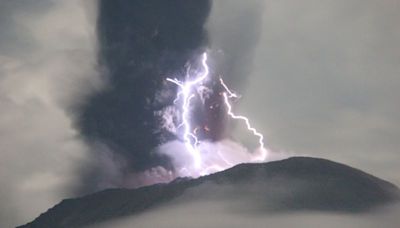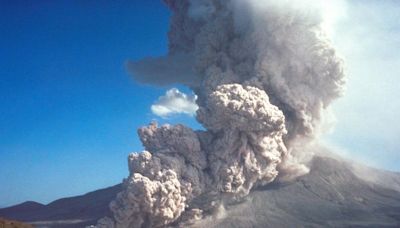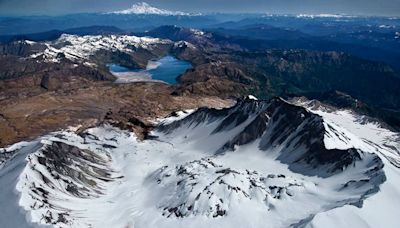Search results
People also ask
What happens when a volcano erupts?
What time did the fire volcano erupt?
Did IBU volcano erupt again?
Which Cascade volcano is most likely to erupt again?
Jul 7, 2018 · Find out which volcanoes are erupting around the world as of 19 April 2024. See the start date, last known activity, maximum Volcanic Explosivity Index (VEI) and Weekly Volcanic Activity Report (WVAR) for each eruption.
- Shishaldin
The symmetrical glacier-covered Shishaldin in the Aleutian...
- Barren Island
Barren Island, a possession of India in the Andaman Sea...
- Nishinoshima
The small island of Nishinoshima was enlarged when several...
- Santa María
Symmetrical, forest-covered Santa María volcano is part of a...
- Heard
Heard Island on the Kerguelen Plateau in the southern Indian...
- Saunders
Saunders Island consists of a large central volcanic edifice...
- Sabancaya
Sabancaya, located in the saddle NE of Ampato and SE of...
- Bezymianny
The modern Bezymianny, much smaller than its massive...
- Latest Weekly Report
The Weekly Volcanic Activity Report is a cooperative project...
- Shishaldin
- Overview
- How do volcanoes form?
- Where are all these volcanoes?
- What are some of the dangers from a volcano?
- Can we predict volcanic eruptions?
- What is the largest eruption in history?
- GeneratedCaptionsTabForHeroSec
These fiery peaks have belched up molten rock, hot ash, and gas since Earth formed billions of years ago.
Volcanoes are Earth's geologic architects. They've created more than 80 percent of our planet's surface, laying the foundation that has allowed life to thrive. Their explosive force crafts mountains as well as craters. Lava rivers spread into bleak landscapes. But as time ticks by, the elements break down these volcanic rocks, liberating nutrients from their stony prisons and creating remarkably fertile soils that have allowed civilizations to flourish.
There are volcanoes on every continent, even Antarctica. Some 1,500 volcanoes are still considered potentially active around the world today; 161 of those—over 10 percent—sit within the boundaries of the United States.
But each volcano is different. Some burst to life in explosive eruptions, like the 1991 eruption of Mount Pinatubo, and others burp rivers of lava in what's known as an effusive eruption, like the 2018 activity of Hawaii's Kilauea volcano. These differences are all thanks to the chemistry driving the molten activity. Effusive eruptions are more common when the magma is less viscous, or runny, which allows gas to escape and the magma to flow down the volcano's slopes. Explosive eruptions, however, happen when viscous molten rock traps the gasses, building pressure until it violently breaks free.
The majority of volcanoes in the world form along the boundaries of Earth's tectonic plates—massive expanses of our planet's lithosphere that continually shift, bumping into one another. When tectonic plates collide, one often plunges deep below the other in what's known as a subduction zone.
As the descending landmass sinks deep into the Earth, temperatures and pressures climb, releasing water from the rocks. The water slightly reduces the melting point of the overlying rock, forming magma that can work its way to the surface—the spark of life to reawaken a slumbering volcano.
Not all volcanoes are related to subduction, however. Another way volcanoes can form is what's known as hotspot volcanism. In this situation, a zone of magmatic activity—or a hotspot—in the middle of a tectonic plate can push up through the crust to form a volcano. Although the hotspot itself is thought to be largely stationary, the tectonic plates continue their slow march, building a line of volcanoes or islands on the surface. This mechanism is thought to be behind the Hawaii volcanic chain.
3:05
Follow a Lava River’s Mesmerizing Path of Destruction
Located in Hawai'i Volcanoes National Park, Kīlauea is one of the most active volcanoes in the world. Watch magma carve a path of destruction in Kīlauea’s otherworldly landscape in this mesmerizing short film by Tyler Hulett.
Some 75 percent of the world's active volcanoes are positioned around the ring of fire, a 25,000-mile long, horseshoe-shaped zone that stretches from the southern tip of South America across the West Coast of North America, through the Bering Sea to Japan, and on to New Zealand.
This region is where the edges of the Pacific and Nazca plates butt up against an array of other tectonic plates. Importantly, however, the volcanoes of the ring aren't geologically connected. In other words, a volcanic eruption in Indonesia is not related to one in Alaska, and it could not stir the infamous Yellowstone supervolcano.
Volcanic eruptions pose many dangers aside from lava flows. It's important to heed local authorities' advice during active eruptions and evacuate regions when necessary.
One particular danger is pyroclastic flows, avalanches of hot rocks, ash, and toxic gas that race down slopes at speeds as high as 450 miles an hour. Such an event was responsible for wiping out the people of Pompeii and Herculaneum after Mount Vesuvius erupted in A.D. 79.
Similarly, volcanic mudflows called lahars can be very destructive. These fast-flowing waves of mud and debris can race down a volcano's flanks, burying entire towns.
Ash is another volcanic danger. Unlike the soft, fluffy bits of charred wood left after a campfire, volcanic ash is made of sharp fragments of rocks and volcanic glass each less than two millimeters across. The ash forms as the gasses within rising magma expand, shattering the cooling rocks as they burst from the volcano's mouth. It's not only dangerous to inhale, it's heavy and builds up quickly. Volcanic ash can collapse weak structures, cause power outages, and is a challenge to shovel away post-eruption.
Volcanoes give some warning of pending eruption, making it vital for scientists to closely monitor any volcanoes near large population centers. Warning signs include small earthquakes, swelling or bulging of the volcano's sides, and increased emission of gasses from its vents. None of those signs necessarily mean an eruption is imminent, but they can help scientists evaluate the state of the volcano when magma is building.
However, it's impossible to say exactly when, or even if, any given volcano will erupt. Volcanoes don't run on a timetable like a train. This means it's impossible for one to be “overdue” for eruption—no matter what news headlines say.
1:10
See a Spectacular Lava "Waterfall" Pour Into the Ocean
The deadliest eruption in recorded history was the 1815 explosion of Mount Tabora in Indonesia. The blast was one of the most powerful ever documented and created a caldera—essentially a crater—4 miles across and more than 3,600 feet deep. A superheated plume of hot ash and gas shot 28 miles into the sky, producing numerous pyroclastic flows when it collapsed.
The eruption and its immediate dangers killed around 10,000 people. But that wasn't its only impact. The volcanic ash and gas injected into the atmosphere obscured the sun and increased the reflectivity of Earth, cooling its surface and causing what's known as the year without a summer. Starvation and disease during this time killed some 82,000 more people, and the gloomy conditions are often credited as the inspiration for gothic horror tales, such as Mary Shelley's Frankenstein.
Although there have been several big eruptions in recorded history, volcanic eruptions today are no more frequent than there were a decade or even a century ago. At least a dozen volcanoes erupt on any given day. As monitoring capacity for—and interest in—volcanic eruptions increases, coverage of the activity more frequently appears in the news and on social media. As Erik Klemetti, associate professor of geosciences at Denison University, writes in The Washington Post: “The world is not more volcanically active, we’re just more volcanically aware.”
SOURCES:
USGS FAQ: How much of the Earth is volcanic?
USGS FAQ: What are some benefits of volcanic eruptions?
Learn about the formation, types, and dangers of volcanoes, the fiery peaks that have shaped Earth's surface and history. Find out how volcanoes are monitored and what are some of the largest eruptions in history.
- 3 min
- Maya Wei-Haas
Minor seismic activity was observed over the past day with occasional small earthquakes detected. The active portion of the lava flow remains warm and was snow-free and steaming in partly cloudy satellite views. The current lava flow began erupting in July 2021.
Jan 17, 2022 · CNN — The eruption of an underwater volcano near Tonga on Saturday was likely the biggest recorded anywhere on the planet in more than 30 years, according to experts.
- 2 min
- Helen Regan
5 days ago · Learn about volcanic eruptions, the explosive or effusive expulsion of molten rock, hot rock fragments, and gases through a volcano. Explore the different types of volcanic eruptions, their causes, effects, and examples from Earth and other planets.
Sep 10, 2023 · Overview. Multimedia. News. Connect. Kīlauea was erupting at the summit most recently from September 10-16, 2023. Several roughly east-west oriented vents on the western side of the downdropped block within Kīlauea's summit caldera generated lava flows onto Halema‘uma‘u crater floor, within Hawai‘i Volcanoes National Park.
